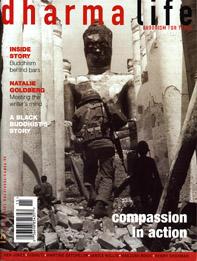Teaching the Descendants
In the Northeast corner of India are the Seven Sisters, the seven Indian states that are tucked away from the rest of this vast country and reached only through a narrow corridor, with Bangladesh to the West, Bhutan and China to the North, and Burma (Myanmar) to the East. Last January three members of the Western Buddhist Order/Trailokya Bauddha Mahasangha, – myself from England, and Chandrabodhi and Amoghabhadra from central India travelled to one of these states – Tripura – to lead a meditation retreat for local Buddhists.
There are an estimated 300,000-plus Buddhists in the Northeast of India, including about 120,000 in Tripura of whom half are from the Chakma tribe. The majority of Chakmas – perhaps as many as 600,000 – live in the Chittagong Hill Tracts of neighbouring Bangladesh, where they have suffered years of marginalisation and persecution since the creation of East Pakistan in 1947. But most of those attending the retreat are settled permanently in Tripura.
The Chakmas believe that their tribe was originally close to or the same as the Sakyan tribe of the Buddha himself who lived in India for 1000 years before migrating to Burma and then to modern-day Bangladesh and Tripura. The Barua tribe of West Bengal, Northeast India and Bangladesh, and the Mog tribe in Tripura, have similar beliefs. Some historians and ethnologists, however, have suggested that the Chakmas began as a Tibeto-Burmese tribe.
Our invitation to visit Tripura came from Bhikkhu Akshayananda, the senior-most monk in Tripura and the head of the Venuvan Buddha Vihara in the state’s small capital, Agartala. Akshayananda himself is from the predominant tribe of Tripura, the Tripuri and he was born into a family which had converted to Christianity several generations previously. But in his teenage years he decided to reconvert to Buddhism.
Most of Tripura’s Buddhists live in villages often exclusively made up of Chakma or Mog tribals. Most of these villages have a resident monk living in a monastery typically made from bamboo. Buddhism in Tripura follows the Theravada tradition, but Bhikkhu Akshayananda explained to us that he also sees a demand for the activities of the Western Buddhist Order, which does not emphasise the traditional role of the monastic sangha. Chandrabodhi introduced the mindfulness of breathing and metta bhavana (loving-kindness) meditation practices and in the afternoons Amoghabhadra took karate sessions, which were very popular with the youth. In the evenings I gave a series of talks based on the Mahamangala Sutta, which was also attended by 20 or 30 others who could not attend the full retreat. I had guessed that while most would have heard the Sutta in Pali they would not know its meaning. The next morning those of us on the retreat met in small groups to discuss the text.
At the beginning of the retreat we asked each retreatant why they had come. A few women had come because of health problems, and they had heard meditation would help. Some of the teenagers said they had been sent by their parents (though one boy said he had come against the advice of his parents and was missing two days of school because he wanted to learn to meditate). The atmosphere during meditation was very still from the outset, and from the second day we were able to introduce periods of silence outside the shrine room – a new experience for most. The harmonious and melodious chanting in Pali introduced by Chandrabodhi and Amoghabhadra was also much appreciated. Everyone was touched to some extent by the Dharma and several left with heartfelt intentions to maintain a regular meditation practice. We are hoping to return to Tripura to run a second retreat in early 2002.
Mahamati



